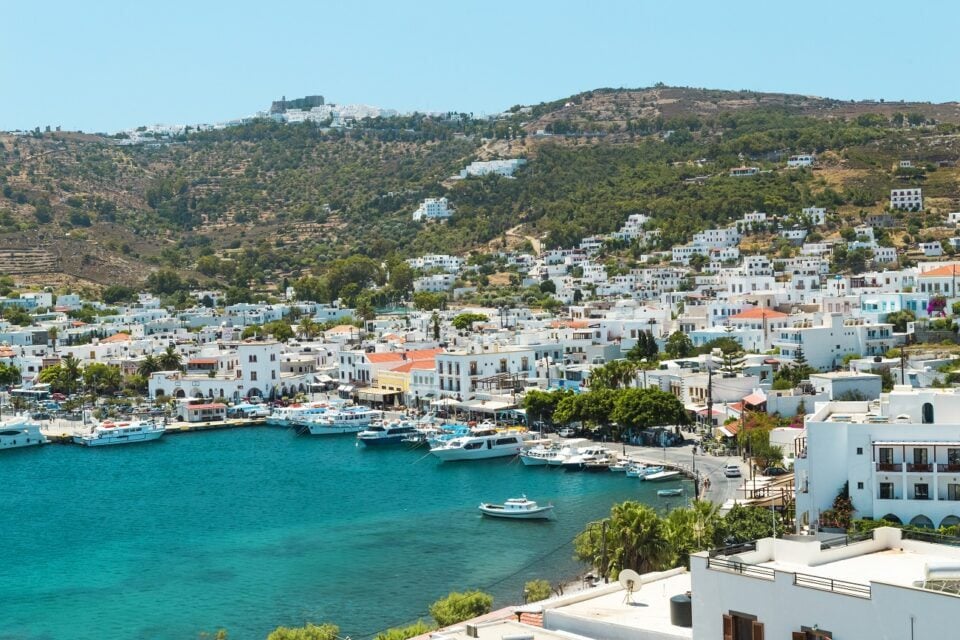The island of Patmos is small and cozy. It takes half an hour to drive from one end to the other. Patmos is perhaps the most religious center of Hellas. They even came up with a very poetic metaphor for it – “Jerusalem of the Aegean Sea”. The main attraction, because of which most tourists come here, is the cave where the great work “Apocalypse” (the same one from the Bible) was written. We will tell you more about the cave below.
If you have long dreamed of not just lying on the sand by the sea, enjoying a cocktail, but finding a secret corner, then Patmos is ideal for you. Here you will find a secluded holiday away from the noise of megacities and the vain bustle of everyday life.
Patmos is washed by the Aegean Sea. All the coastal towns and villages are very cozy and make you want to stay longer. Their narrow alleys are filled with quiet provincial life. A little more than three thousand people live here.
The island consists of three parts, which are connected to each other by thin isthmuses a couple of kilometers wide. Patmos belongs to the Dodecanese group of islands. Here you will not find luxurious vegetation – the island consists of rocks and there is practically no forest on it – but here you can find something more: peace and tranquility.
How to get there?
Patmos, Greece, is a rather secluded island. Getting there requires some effort. That’s probably why beach holidays there aren’t as developed as on the popular Greek islands. Patmos doesn’t have its own airport, so the only way is by water. You can fly to Athens (and see the sights ), and from there take a ferry to Patmos. Here you should keep in mind that there may not be enough seats on the ferry, so it’s best to book your ticket in advance.
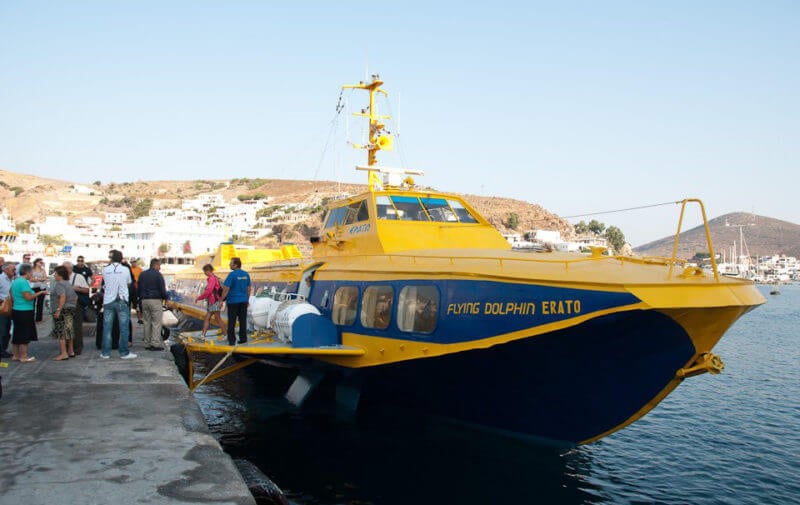
Patmos can also be reached from neighboring islands. For example, from the island of Kos . Catamarans depart daily from there, and the journey will take a couple of hours. Transport also runs from the fertile island of Samos . There is a boat called Flying Dolphin, which will take you to your destination. The journey will take about an hour. Prices and timetables for water transport can be found on the website www.aegeanflyingdolphins.gr.
In addition, you can get to Patmos from the island of Rhodes. However, Rhodes is further away. It will take four hours to sail on a catamaran. It goes every day except Mondays. However, if you are prone to seasickness, such a long journey may throw you off track. But if you have set yourself the goal of visiting this pearl of Christianity, the trials of the road will not knock you off course!
What to see on the island?
Deserted, sparsely populated, covered with thorn bushes, inaccessible, in places waterless and dry. This is how the island appears to most new arrivals. Nevertheless, since 2006, Patmos (Greece) has been recognized by UNESCO as a World Heritage Site. It is famous for the fact that John the Theologian served his exile here. He is the only apostle who died a natural death, and it was he who wrote his best work on Patmos – “Apocalypse”, or “Revelation”.
Cave of Revelation
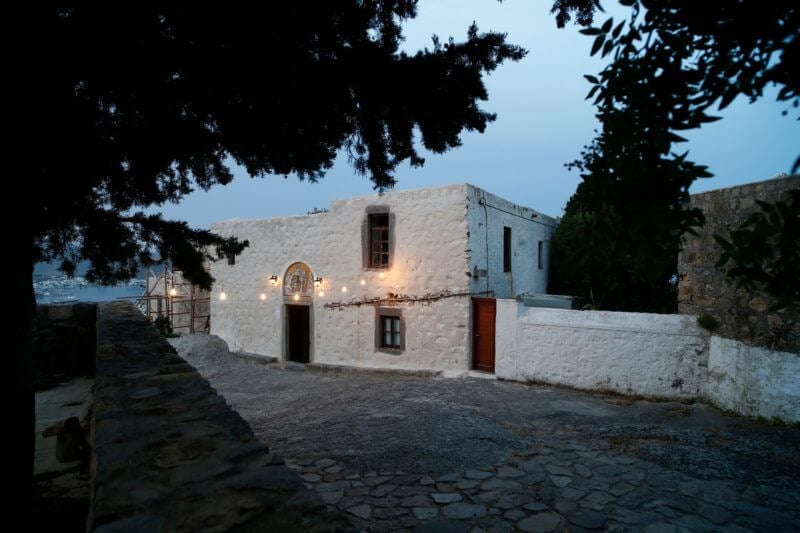
This is a real treasure of the island. According to legend, Apostle John the Theologian wrote the book “Apocalypse” (the name of the last book of the New Testament) here. If anyone doesn’t know, it is about what awaits people at the end of the world. The cave is located between the Skala harbor and the city of Patmos. It is also called the Holy Grotto. In general, it does not look much like a cave, more like a church in a rock. Entrance – 3 euros.
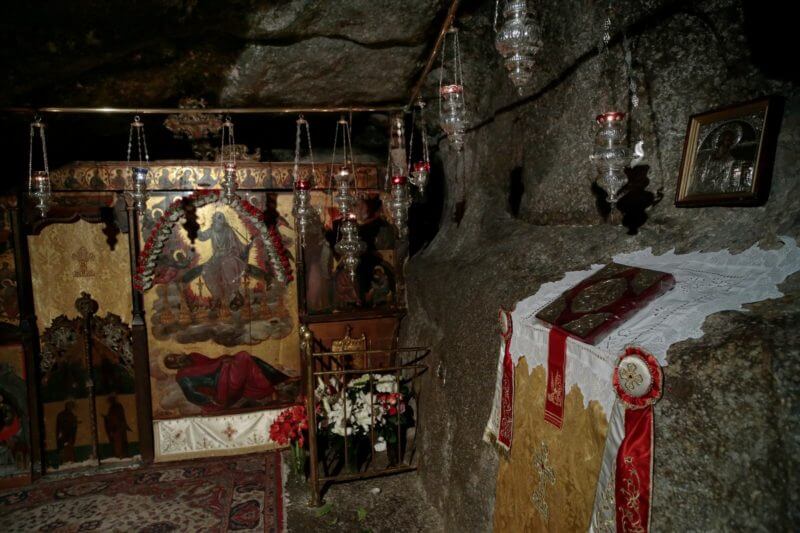
According to legend, Saint John found shelter here when he was exiled by order of the Roman Emperor Domitian. A monk meets tourists in the cave and tells everyone who wants stories from the Apocalypse and fragments from the life of the Theologian. You can see the stones on which, according to legend, the saint slept (he laid his head on them, like a pillow). The places here are beautiful, and some people come up with an amazing thought: how could such a gloomy story be written in such a wonderful place.
Monastery of St. John the Evangelist
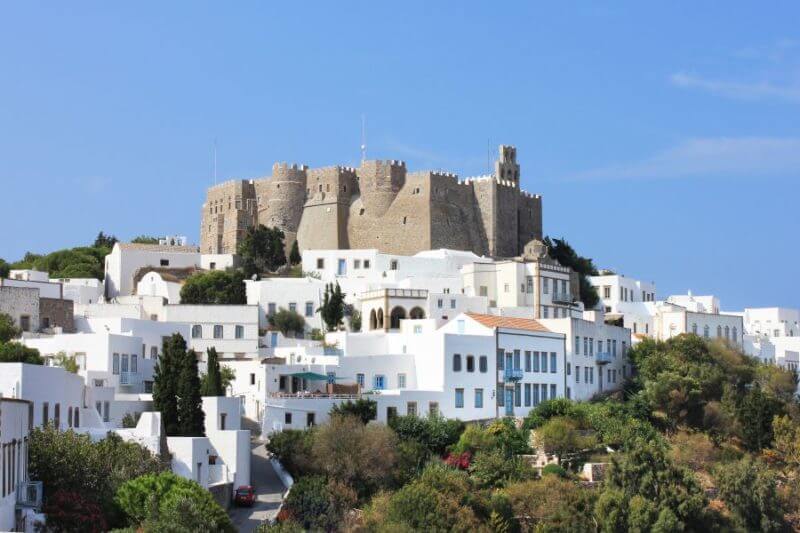
An opportunity to plunge into the early Middle Ages. The monastery of the 11th century, stands higher in the mountains than the cave, and resembles a fortress. Many who have visited Patmos have photos of this structure. The views here are simply breathtaking! Externally, it is a typical Greek monastery, which can be seen from any part of the island. The monastery is located high above Chora, the capital of the island. People are attracted by its magical frescoes, fortified high thick walls, towers and ramparts.
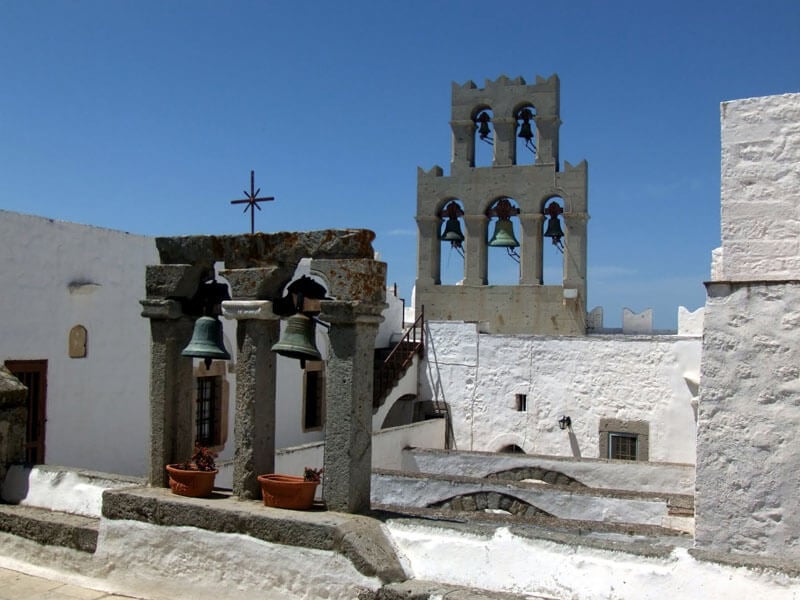
There is a nice well here where you can get holy water. An interesting museum. Gloomy monks who nevertheless sell delicious wine of their own production. Tourists note that the nature and the air itself here give peace. In general, a real shrine. Getting to the monastery is not difficult: you can even walk from the capital. The journey will take about forty minutes, but be prepared that the road is uphill. There is also a bus to the destination.
The cost of visiting the monastery is 4 euros, the museum – 2 euros.
City of Chora
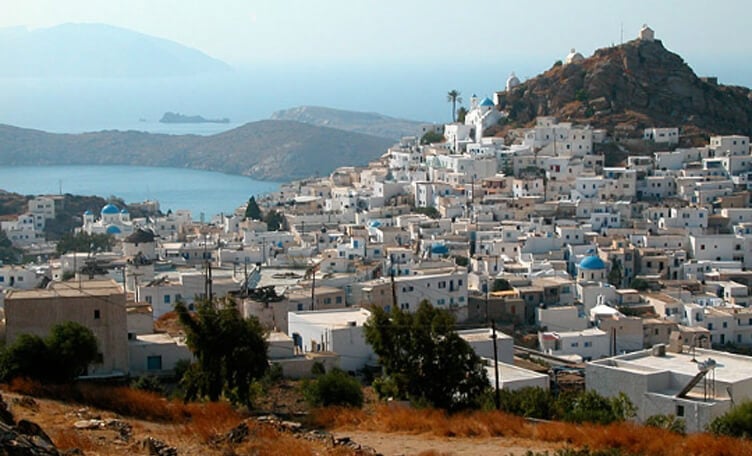
The capital of the island of Patmos. Settlements are usually formed around large enterprises. Here, everything began with the construction of the above-mentioned majestic monastery of St. John the Theologian. In the 16th and 17th centuries, the city flourished, and most of the picturesque mansions in the city center date back to this time.
The snow-white buildings have flat roofs. This is not a coincidence or the invention of a crazy architect: this was done to save rainwater. Narrow alleys and white chapels are all around. Antique doors, chic ceramic vases with plants, a real pleasure just to walk along the streets.
The view from the top is stunning. It feels like a fairy-tale toy town. There are many shops and taverns in Chora, and the prices are quite low, unlike the popular islands of Greece or the mainland.
The center of Chora is the main square. The streets are only accessible on foot or by moped because they are very narrow. This gives the town a special charm.
Windmills
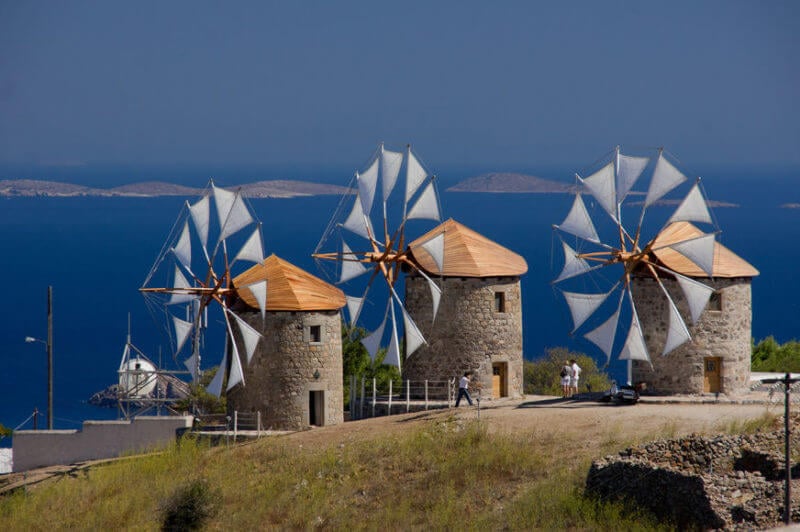
Don Quixote immediately comes to mind, these are the windmills you imagine when you read the book: round, cozy, in general – real. It is surprising that the windmills on Patmos are gray, although on other Greek islands they are all white stone. Among the guests of Patmos they are considered a real feature, thanks to them the island received a prestigious tourist award.
Two of the mills are very old, more than five hundred years old. The third was built much later. Today it is a whole wind complex-museum, where many people come.
The mills are located near the Monastery of St. John the Theologian, so if you are planning to get to the monastery from Chora on foot, be sure to stop by here. One of the mills is open, tourists are allowed up, and a truly stunning view opens up from the inside.
Beaches of the island
The island of Patmos, Greece, is much more famous for its Christian landmarks than its beaches. But the pleasant climate and gentle sea allow you to splash on the shore almost until October. There are three main beaches on Patmos.
Psylly Amos
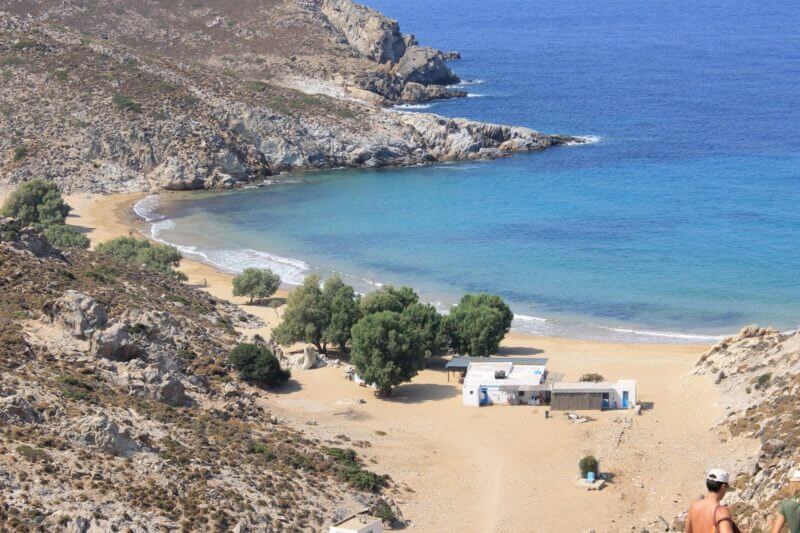
Situated 10 km from Chora. This is one of the best beaches in Patmos. It is hidden in a bay from the wind. It amazes with the beauty of its natural landscape. Wonderful warm and clean water, excellent entry into the water, fine sand. You can settle down on your own towels, so as not to rent sun loungers. It is a pleasure to lie on the sand, under the shade of trees.
There is also a small cafe, not pretentious, a regular seaside eatery. Tables, wooden chairs, people sitting right in their bathing suits.
Agios Theologos
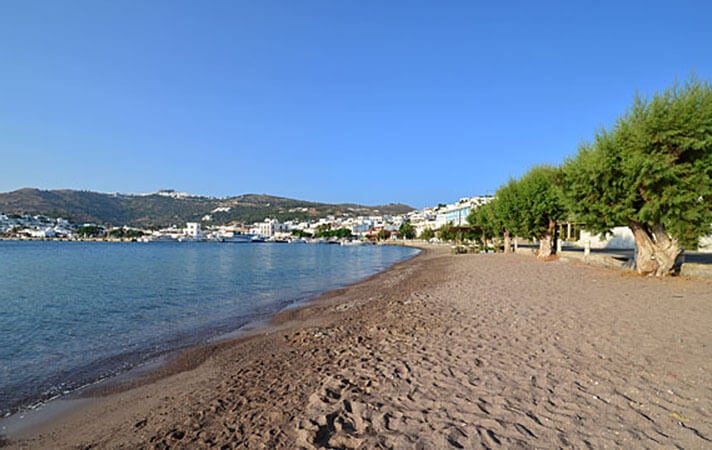
Also sheltered from the winds by a bay. The beach is sandy, the sea is transparent, the entry into the water is wonderful. Just an ideal place for children, even very tiny ones. There are taverns where you can have a snack for little money with local cuisine and fresh seafood.
Agios Theologos is served by boats from the port, but you can also get there by car or motorbike, or on foot in 25 minutes from the nearby village. Peace and quiet reign here.
One of the nuances is that the sun hides behind the mountains early, so if you want to sunbathe, it’s better to arrive in the morning.
Agrio Meadows
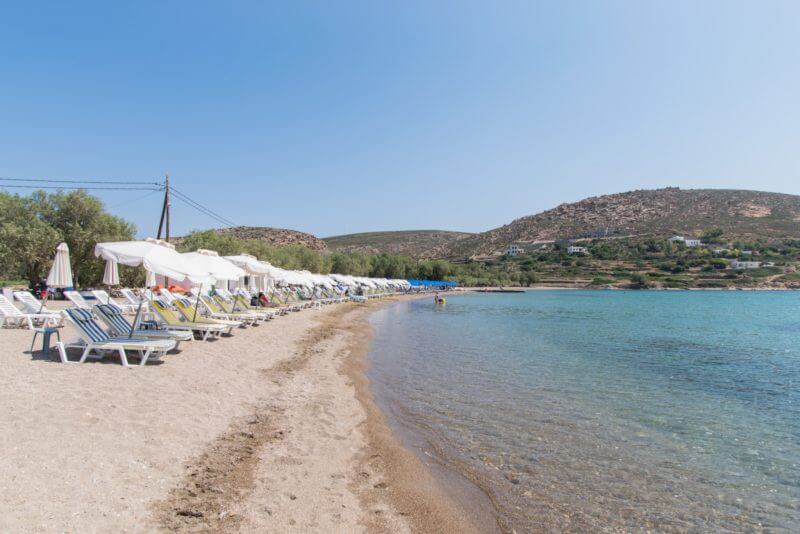
The beach, hidden from the main tourist routes of Patmos, is a very nice and secluded place. The sea is beautiful and clean, the surface is sandy with a mixture of pebbles. At the end of the beach there is a nice Greek tavern. There is no exquisite cuisine there, but you can have lunch or order a cocktail there. Agrio Livadi is not yet popular with tourists, it is rather a quiet meeting place for locals, where they come to relax at the end of the day.
The cost of renting a sun lounger per day is 5 euros.
A brief summary
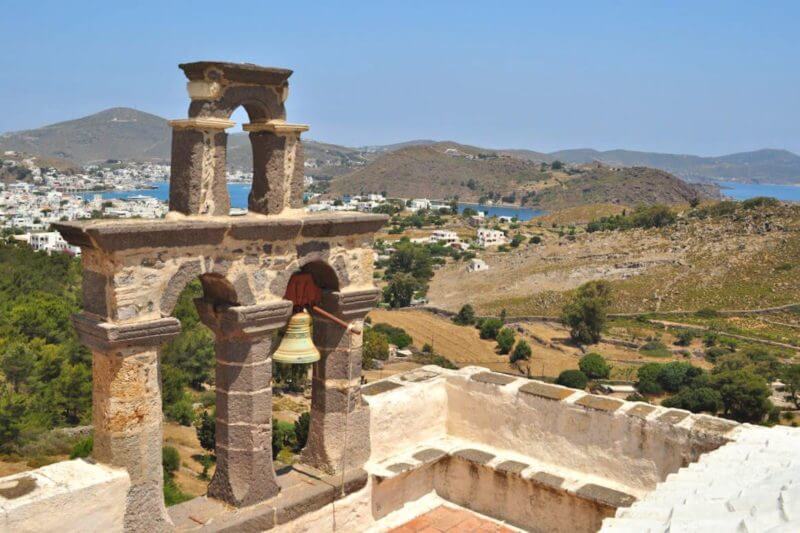
You will certainly be captivated by the endless capes with amazing views and majestic grottoes. Unlike its green neighbor Rhodes , Patmos looks deserted. If there are trees here, they are mostly coniferous. But! It is easy to breathe here. There is no excess of cars. Around there are untouched expanses of wild terrain, the air is permeated with the aroma of coniferous trees.
Beach infrastructure is poor, but the beaches are all sandy. The island of Patmos in Greece (photos confirm this) is imbued with a religious spirit, white-stone churches and bell towers are at every turn. Instead of drunken, depraved tourists, there are mostly pilgrims who have come here on purpose.
To save money, you can rent a quad bike or a motorcycle. Taxi is prohibitively expensive. For the most athletic, we recommend walking on foot, because all the most interesting things can be seen in the mountains. The local population on Patmos is special: people are polite, listen attentively and do not try to sell anything.
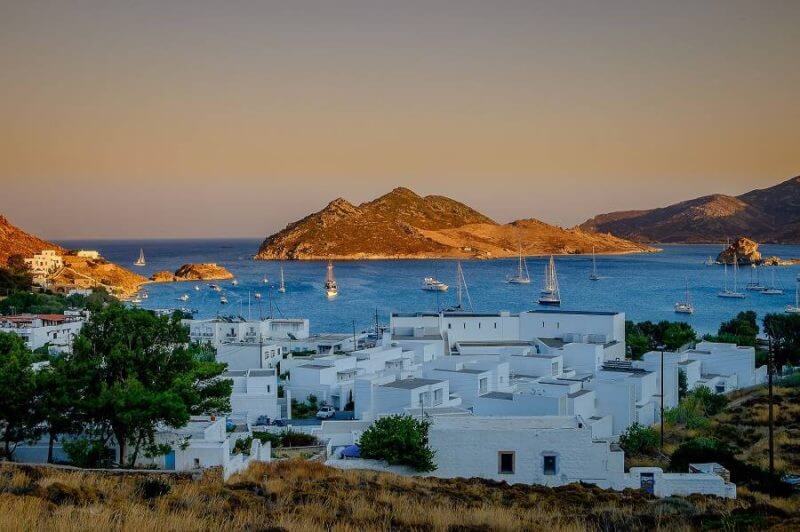
Windy weather is typical for the dark time of day. The best time to visit is from July to September, the air temperature during the day is comfortable, about 25 degrees. The views are stunning, nature beckons. It is hard to believe that people were exiled here, that a living apostle walked here, and that it was on Patmos in Greece that the terrifying book of Revelation was written. After all, the island of Patmos breathes grace and charges with optimism for the whole year ahead.

